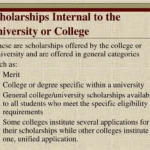My Scholarship Journey: Unlocking External Funding for Your Dreams
I remember staring at the tuition bill for my dream university. My stomach did a little flip – not the good kind. It wasn’t just big; it felt like a mountain I couldn’t possibly climb. My parents had already stretched themselves thin, and while the university offered some aid, it wasn’t enough. I felt a knot tighten in my chest, a cold fear that my dream might just be that – a dream, forever out of reach.
But then, a glimmer. A friend, who seemed to have a magical knack for finding opportunities, mentioned "external scholarships." I blinked. "External what now?" I asked, feeling utterly clueless. She explained they were funds that didn’t come directly from the university itself, but from other organizations, companies, or even individuals. It was like a lightbulb went off in a very dark room. This, I realized, could be my lifeline.
If you’re reading this, chances are you’re standing at a similar crossroads. You’re passionate about your education, but the financial burden feels overwhelming. Trust me, I get it. And I’m here to tell you: external scholarships are real, they are out there, and you absolutely can get them. This isn’t some secret club; it’s a path many of us have walked, and I want to share my journey, my struggles, and my wins, to help you navigate yours.
The Big Discovery: What Exactly Are External Scholarships?
Before I dive into my search, let’s get clear on what we’re talking about. Imagine your college or university has its own pot of money for students – that’s "internal" aid. External scholarships are like hundreds, even thousands, of other pots of money, scattered all over the place, waiting for someone just like you to claim them.
These funds come from a vast array of sources:
- Non-profit organizations: Think Rotary Clubs, Lions Clubs, community foundations.
- Corporations: Many big companies offer scholarships as part of their community outreach or to encourage talent in specific fields.
- Professional associations: Groups for engineers, nurses, artists, etc., often have funds for students entering their profession.
- Foundations: Large philanthropic organizations set up to support various causes, including education.
- Individuals: Sometimes, generous individuals establish scholarships in memory of a loved one or to support a particular group of students.
The best part? These scholarships can often be stacked on top of your university’s financial aid. This means more money directly towards your education, reducing your loans, or even covering living expenses. It’s not just about covering tuition; it’s about gaining financial freedom to focus on your studies.
Where I Started My Hunt: My Digital Detective Work
My first step, after that eye-opening conversation with my friend, was to hit the internet. Hard. I treated it like a detective case, and my main tools were search engines and a good old-fashioned spreadsheet.
Here’s where I looked, and where you should too:
-
Big Scholarship Search Engines: These were my initial go-to. Sites like Fastweb, Scholarship.com, Cappex, and College Board’s BigFuture became my daily haunts. You create a profile, input your interests, academic achievements, background, and they match you with scholarships. It’s a great starting point, but remember, these are just aggregators.
- My tip: Don’t just rely on the matches. Browse categories, use specific keywords related to your major, hobbies, or unique characteristics.
-
My University’s Financial Aid Page: Even though they’re "external," many universities list external scholarship opportunities they’ve been made aware of. It’s worth a look! Sometimes, local companies contact universities directly with scholarship offers.
-
Local Community Organizations: This was a goldmine I almost overlooked. I searched for "scholarships [my hometown/county]" and found so many local groups: the Rotary Club, the local Chamber of Commerce, women’s clubs, even my high school’s alumni association. These often have fewer applicants, meaning better odds!
- My tip: Don’t underestimate small, local scholarships. A few hundred or a thousand dollars here and there really add up.
-
Professional Associations for My Major: Since I was aiming for a career in marketing, I looked up associations like the American Marketing Association (AMA) or other regional marketing groups. Lo and behold, they had scholarships for aspiring marketers!
-
My Parents’ Employers/Unions: Some companies offer scholarships to children of their employees. My dad’s union, surprisingly, had a small scholarship fund. Always ask!
-
My High School Counselor’s Office: They often have binders full of local scholarship opportunities, especially for recent graduates.
I kept a spreadsheet of every scholarship I found: name, amount, deadline, eligibility criteria, and required documents. It helped me stay organized and avoid missing deadlines. Believe me, organization is your secret weapon in this game.
The Application Gauntlet: How I Faced the Challenge
Finding scholarships was one thing; actually applying for them was another. It felt like I was constantly writing essays, gathering recommendation letters, and filling out forms. It was tough, sometimes discouraging, but every step was a learning experience.
1. Understanding Eligibility: Read the Fine Print!
This sounds obvious, but I learned it the hard way. I’d get excited about a scholarship, spend time on it, only to realize I didn’t meet a specific requirement. Save yourself the heartache: read the eligibility criteria thoroughly before you even start. Is it for a specific major? A certain GPA? A particular demographic? Do you need to volunteer a certain number of hours? Be honest with yourself.
2. The Essay: Telling My Story, Not Just Repeating My Resume
Ah, the scholarship essay. This is where many people stumble, and where I felt I truly shined (after a lot of practice!). Don’t just list your achievements; tell a story. Scholarship committees read hundreds of applications. They want to know who you are, what drives you, and why you deserve this money.
- My Approach: I picked a moment or an experience that genuinely shaped me. For one essay, I wrote about my experience volunteering at a local animal shelter and how it taught me about responsibility and compassion – qualities I felt were relevant to my future career. For another, I talked about a challenge I overcame in a school project and what I learned from it.
- Show, Don’t Tell: Instead of saying "I am a leader," describe a time you took initiative and led a team. Instead of "I am passionate about X," explain why and how that passion manifests.
- Be Authentic: Don’t try to guess what they want to hear. Be yourself. Your unique voice is your superpower.
- Proofread, Proofread, Proofread: A single typo can make you look careless. Read it aloud. Ask a trusted friend or teacher to read it. Use grammar checkers.
3. Recommendation Letters: Choosing My Champions
Most scholarships ask for letters of recommendation. I learned it’s not just about asking your favorite teacher; it’s about asking someone who knows you well and can speak to the qualities the scholarship values.
- Who I Asked: I asked my English teacher, who knew my writing skills and my dedication, and my volunteer supervisor, who could attest to my work ethic and commitment outside of academics.
- How I Asked: I approached them well in advance (at least 2-3 weeks before the deadline) and provided them with everything they needed: my resume, the scholarship requirements, what I planned to write in my essay, and why I thought this scholarship was a good fit for me. Make it easy for them to write a strong letter for you.
- Follow Up: A polite reminder a week before the deadline is perfectly acceptable. And always, always send a thank-you note!
4. Transcripts and Test Scores: Getting the Paperwork Ready
This part is usually straightforward but requires attention to detail. Make sure you request official transcripts and test scores well ahead of time. Some schools or testing agencies take a while to process these.
5. The Interview: My Moment to Shine (or Stumble)
Some scholarships require an interview. I had a few, and they were nerve-wracking! But I learned to see them as another opportunity to showcase my personality and passion.
- Preparation: I researched the organization, understood their mission, and thought about why I was a good fit. I practiced answering common interview questions (e.g., "Tell me about yourself," "Why do you deserve this scholarship?").
- Dress the Part: Even if it was a virtual interview, I dressed professionally. It showed respect.
- Be Enthusiastic and Ask Questions: Show genuine interest. Ask thoughtful questions about their organization or what they look for in recipients.
6. Staying Organized: My Spreadsheet Was My Best Friend
Seriously, get a spreadsheet. Or a calendar. Or a dedicated notebook. Anything that helps you track:
- Scholarship name
- Deadline
- Amount
- Eligibility requirements
- Required documents (essay, recommendations, transcripts)
- Date submitted
- Status (applied, waiting, rejected, awarded)
This kept me sane and prevented me from missing deadlines.
My Wins, My Losses, and the Power of Persistence
Not every application turned into a scholarship. In fact, most of them didn’t. I received plenty of "we regret to inform you" emails. Each one felt like a small punch to the gut. But here’s what I learned: every "no" just brought me closer to a "yes."
I remember one particular scholarship, a regional one for students pursuing a degree in a specific STEM field (which I had a minor in). I spent weeks on the essay, tailored my recommendation letters, and even did an interview. When I got the rejection email, I was crushed. I almost gave up.
But then, I remembered my tuition bill. I remembered the dream. So, I took a deep breath, reviewed my application, and looked for what I could improve. I realized I hadn’t fully connected my minor to my main career aspirations. It was a subtle but important detail.
My biggest win came from a local community foundation. It wasn’t the largest scholarship I applied for, but it was significant. I wrote about how my family’s struggles had ignited my drive for education and how I planned to use my degree to give back to my community. When I got the call, I literally jumped for joy. The relief that washed over me was immense. It wasn’t the only scholarship I received, but it was the one that truly changed the game for me, allowing me to take fewer loans and focus more on my studies.
My Hard-Earned Wisdom: Tips for Your Scholarship Quest
So, after all that, what would I tell the younger me, or someone just starting this journey?
- Start Early, Seriously Early: Don’t wait until the last minute. Scholarship applications can be time-consuming. Begin your search months, even a year, before you need the funds.
- It’s a Numbers Game: Apply for many scholarships. The more you apply for, the better your chances. Don’t put all your eggs in one basket.
- Tailor Every Application: Avoid the "copy-paste" trap. Each scholarship has different criteria and a different focus. Customize your essays and answers to fit what they are looking for.
- Recycle Wisely: While you shouldn’t copy-paste, you can adapt parts of your essays or a strong recommendation letter for different applications. Just make sure to tweak them significantly to fit the new context.
- Show Your Personality: Committees want to fund real people, not just academic robots. Let your unique voice, passions, and experiences shine through.
- Don’t Be Afraid to Ask for Help: Reach out to teachers, counselors, mentors, or even family friends to review your essays or practice interview questions.
- Proofread Everything: I cannot stress this enough. A clean, error-free application shows you’re serious and detail-oriented.
- Look Beyond the Big Names: Small, local scholarships often have less competition. They’re definitely worth your time.
- Keep Going: Rejection is part of the process. Don’t let it discourage you. Learn from it, adjust, and move on to the next opportunity. Your persistence will pay off.
- Track Everything: My trusty spreadsheet was invaluable. Knowing what you’ve applied for and what’s still pending helps you stay organized and motivated.
Your Dream is Within Reach
My journey with external scholarships wasn’t easy. It required effort, resilience, and a lot of late nights. But standing here today, having completed my education with significantly less debt than I would have had otherwise, I can tell you it was absolutely worth it.
External scholarships aren’t just about money; they’re about validating your hard work, your potential, and your dreams. They’re about empowering you to pursue the education you deserve without the crushing weight of financial worry.
So, take a deep breath. That mountain of tuition? It’s climbable. Start your search, gather your tools, tell your story, and most importantly, believe in yourself. Your dream university, your dream career, your dream future – they’re waiting for you. Go get ’em. You’ve got this.



